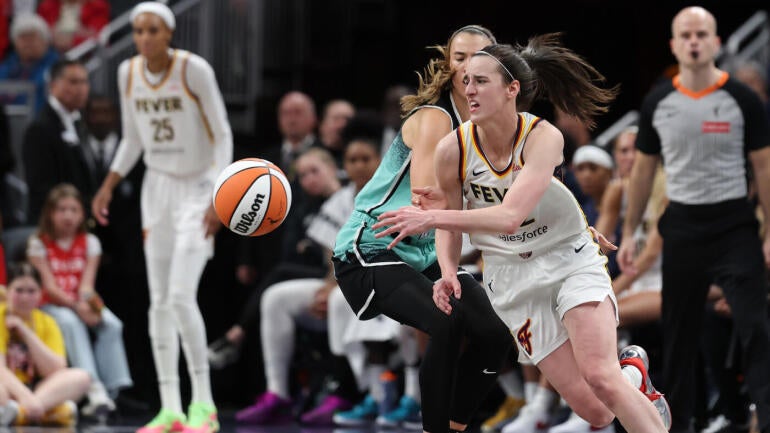

Indiana Fever star Caitlin Clark will miss at least the next two weeks after being diagnosed with a quad strain, the team announced on Monday. Clark’s injury will force her to miss a minimum of four games, starting with the Fever’s contest against the Washington Mystics on Wednesday.
Clark’s upcoming stint on the sidelines will be the first of her professional career. In fact, it will end a streak of 185 consecutive games played dating back to her freshman year of college at Iowa.
After a historic rookie campaign, Clark was expected to challenge for the MVP award this season. She put up a triple-double in the Fever’s opener, and despite a few poor shooting games, was averaging 19 points, six rebounds and a league-leading 9.3 assists for the 2-2 Fever.
While Clark’s quad strain does not appear to be a long-term issue, it’s still a big blow for the new-look Fever, who will have to figure out how to play without their superstar — something they don’t have much experience doing. Ahead of Wednesday’s game against the Mystics, here’s a look at the on-court impact of Clark’s injury.
Who starts?
The first question is who takes Clark’s spot in the starting lineup. Fever coach Stephanie White did not have an answer after practice on Monday, and said she wanted to take some time to evaluate her choices. By Tuesday, White had come to a conclusion, and told that Sydney Colson would enter the starting lineup.
Colson, who made her WNBA debut back in 2011 and won two championships with the Las Vegas Aces in 2022 and 2023, was brought in primarily for her experience and leadership and has only received spot minutes thus far. She is a veteran who knows how to run an offense, though, and can provide some strong point of attack defense.
At the very least, Colson will keep the Fever organized and allow Kelsey Mitchell to remain an off-ball threat.
“[Colson] is an elite communicator,” White said. “She is in every huddle that we have, whether she’s on the floor or not. She sees things from that point guard position. And getting us into offense. It’s gonna look different without the ball in Caitlin’s hands. What are our looks, who can we get our looks for? And then the ability to communicate that to everybody in live action. That’s the piece that we’re still growing with. We can’t call a timeout every time to get a matchup or recognize a switch, so she can help us with that on the floor.”
White added that Sophie Cunningham, who will remain in a reserve role, will also get some reps running the offense.
A different identity without Clark?
Clark is unlike any player the WNBA has ever seen. Her long-range shooting and elite playmaking warps defenses to the nth degree. When she’s on the floor, whether she has the ball or not, defenses are forced to focus nearly all of their attention on her.
And Clark is almost always on the floor. She has never missed a game since joining the Fever, and has averaged 35.4 minutes per game in her WNBA career. When Clark does sit, it’s usually just for a few minutes at a time. Now, the Fever will have to figure out how to play entire games without her.
No one on the Fever — or the league, for that matter — can replicate what Clark does. So will the Fever have to change their identity while she’s on the sidelines? White told reporters on Monday that she doesn’t think Clark’s absence will change how the Fever play, but it will change what they emphasize.
“Our off-ball actions, as opposed to some of our on-ball actions, when we get to our on-ball actions, utilizing our personnel in a different way,” White said, when asked what might be different. “You might not see as much of [Aliyah Boston] getting the ball on a dive in the pick-and-roll as you would in some of the other off-ball screening actions that get her to that point. Or where our shots come from. A lot of times with [Clark] and the ball in her hands, our shots are coming above the break, now we might get the ball moving endline to endline when we’re moving it side to side.
“I don’t think it changes how we play, I just think it just changes the emphasis on the actions that we get to.”
To briefly expand on one example White mentioned, Boston spent her entire college career and rookie season operating as a back-to-the-basket center. When Clark arrived and the Fever started running a more pick-and-roll heavy offense, Boston had to adjust, and has done well to improve as a roller.
With Clark sidelined, the Fever may not run as many high pick-and-rolls as they did to start the season. And when they do go to that action, teams aren’t going to trap Colson, as they do with Clark, which often allows Boston to play four-on-three in space.
In order to ensure that Boston still gets high quality touches, the Fever may add some more traditional post-up looks. Boston is scoring 1.455 points per possession in the post this season, and has the size and touch around the basket to bully opponents who let her play one-on-one. And if teams send multiple defenders her way, that could allow the Fever to put teams in rotation and play against an advantage even without Clark on the floor.
Can the Fever survive without their engine?
As previously noted, the Fever don’t have much experience playing without Clark, who has only sat for 20 total minutes in their first four games. Their most-used non-Clark lineup so far has played four minutes together. Her absence will be a shock to the system.
Clark’s mere presence makes everything easier for her teammates, and as long as she’s out there they have a very high floor. Even as they’ve tried to integrate numerous new players and a new coach, the Fever are 2-2, with their two defeats coming by a combined three points.
In Clark’s 140 minutes of action, the Fever have a 107.5 offensive rating, and that’s despite the fact that their 3-point shooting has been average — 10th in attempts per game (21) and sixth in percentage (34.5) — and their free throw shooting has been a disaster (63%, 11th in the league).
When Clark has not been on the court, the Fever’s offensive rating has plummetted to 82.2. For reference, the Chicago Sky are last in the league in offensive rating at 84.3. The sample size without Clark is extremely small, but even so, it’s clear how much of an impact she makes.
The good news for the Fever is that they have a much deeper team than they did last season.
Natasha Howard already won a game against the Atlanta Dream nearly by herself; Bonner, despite her early offensive struggles, is a proven scorer and has been a big help on defense; Cunningham is a versatile wing on both sides of the ball; Colson and Turner have provided energy, particularly on the defensive end, and leadership.
That quintet, along with All-Stars Boston and Mitchell, is more than capable of holding down the fort until Clark returns. Especially when you look at the Fever’s schedule.
Their next four games are against the Washington Mystics, Connecticut Sun, Mystics and Chicago Sky. The Mystics have been better than expected, but are still a likely lottery team, while the Sun and Sky are winless. Even without Clark, the Fever are going to have more overall talent in all of those games.
This news was originally published on this post .







Be the first to leave a comment